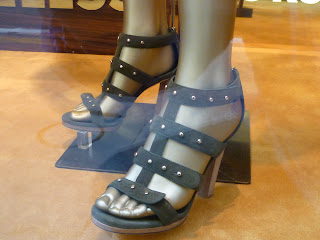 |
| Fontana del Nettuno - Piazza Maggiore |
 |
| The Old Stock Exchange - now a Library |
 |
| Do you think they take their Crudo serious or what? |
 |
| Inside the red arched sidewalks |
 |
| Le Due Torre- mentioned in Dante's - The Inferno |
 |
| Santo Stefano Basilica which connects seven church's inside |
 |
| Cortile di Pilato- the basin where Pilate washed his hands after condemning Christ |
 |
| Outside view of the quaint arched passageways |
It was a beautiful weekend in Tuscany which started out con viaggio in treno a Emilia-Romagna - an area just north of Firenze. The temperature here has been in the mid 50's with some days reaching above 60 degrees. Before entering the train you must punch your ticket in a machine prior to boarding. I assumed that someone would check my ticket later on but to my surprise no one did. I sat down next to un uomo da Milano who proceeded to show me a woman's shoe collection which he proudly produces. He was a distinguished looking man and we were having an enjoyable conversation even though my Italian was limited. However, he soon informed me that we were all assigned a car number as well as a seat assignment and that I was in the wrong area. So unfortunately I had to move. On the train ride we passed through snow capped mountains and the views were beautiful. Upon arriving to Bologna the temperature was similar to Firenze.
So what is the Emilia- Romagna area noted for? The question can be answered in one word - FOOD- along with some other interesting tidbits. This area spells out 4 towns, dozens of food, and a mouthful of flavors that you will never forget. In Emilia, Italia's most famous food region, you can discover simple tastes that exceed all expectations. The secret to this region is not the discovery of new and exotic delicacies, but rather the rediscovery of foods you thought you knew - in much better versions than you have ever tasted before. Lets take one taste at a time. Parma- is the world's capital of prosciutto crudo- raw cured ham (crudo for short) - we know it as prosciutto di parma. The best crudo di parma is cut razor thin and have a light rosy red color. It is silky, less salty than we are use to in the states, more subtle yet flavorful at the same time. Reggio Emilia, is the birthplace of the crumbly and renowned Parmigiano - Reggiano cheese which can be aged up to 4 years. Questo formaggio can be served grated over pasta, by itself in chunks as an appetizer accompanied by salumi or as a dessert when it might be drizzled with honey or Modena's balsamic vinegar. Modena- is home to Aceto-Balsamico Tradizionale di Modena which is made from the Trebbiano grape must. Cooked over an open fire and then reduced and fermented from 12 to 25 years. It takes 6 gallons of must to produce one quart of 12 year old vinegar. This intense and syrupy concoction can be drizzled over strawberries, cheese, grilled meats yet some even drink it as an after dinner liquer. Finally we have the city of Bologna "the fat". This is the birthplace of tortellini , not to mention specialties such as mortadella and ragu ( which is bolognese sauce). Tortellini can be served asciutta - dry with bolognese sauce or in brodo where it is immersed in a beef broth.
The charm of centro Bologna is its red- arcaded sidewalks and passageways which can be attributed by the city counselors at the beginning of the 13th century. Roads could not be built without the porticoes. "Bologna the fat" arguably has the best food in Italy. Besides indulging in it's wonderful food you can see: two landmark towers mentioned by Dante in The Inferno, the old stock exchanged now turned into a library or Santo Stefano which is a basilica that actually contains seven churches connected together. Inside the basilica is a courtyard that is called Cortile di Pilato ( Pilate's Courtyard), named for the basin in the center. It is said that Pontius Pilate washed his hands in this basin after condemning Christ.

Sunday was another gorgeous sunny day. I was so exhausted from my trip to the E/R area that I relaxed most of the day. However, my neighbors once again asked me over for la cena. We had wonderful homemade manicotti, then pork cooked on the open hearth fireplace which had a subtle smoky perfumo, along with insalata and a side dish of olives that were picked from the tree in front of the house where I am staying. The olives had to be brined for three months to withdraw the bitterness out of them. I was then lead to an area to observe hanging dried sausage - this past Thurday my neighbors made their own sausage and I was told that it must hang for ten days. Of course the sausages were made both ways -sweet and with whole peppercorns. After dinner we had formaggio and then fruit all capped off with demitasse coffee con grappa. As a home baked cranberry pie was presented, I learned that it was my neighbors 39th wedding anniversary. Out came the Vin Santo and more dolci. So I of course granted my congratulazioni to this adorable couple. Bravo!!





















































